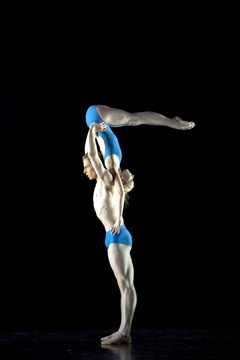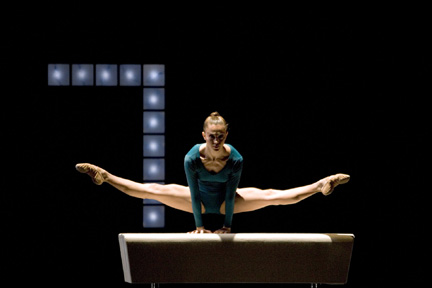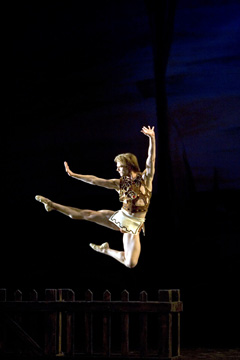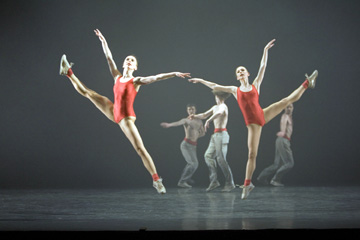Looking for the New
“The
Four Seasons”
Birmingham Royal Ballet
Hippodrome
Birmingham, England
March 9 – 12 2005 and touring
by
John Percival
copyright
©2005 by John Percival
 When
David Bintley took over as director of Birmingham Royal Ballet ten years
ago, he declared that his intention was to run a creative company, and
despite the notorious difficulty of attracting audiences to unfamiliar
work, he has succeeded. Of course BRB has its three big Tchaikovsky ballets,
its “Giselle” and “Coppelia”, but they don’t
hog the repertory. Most performances comprise works created within the
lifetime of many supporters, and a good proportion of them specially made
for Birmingham. Take this year’s spring and summer seasons, for
instance: only one big dramatic ballet, Kenneth MacMillan’s “Romeo
and Juliet”, and a profusion of mixed bills including four creations
plus the first British production of the recreated Nijinsky “Rite
of Spring”. Frederick Ashton, George Balanchine, John Cranko and
Hans van Manen are represented, and Bintley modestly features only one
of his own works, a revision of “Les Petits Riens” which he
made for the Royal Ballet School in the early 1990s.
When
David Bintley took over as director of Birmingham Royal Ballet ten years
ago, he declared that his intention was to run a creative company, and
despite the notorious difficulty of attracting audiences to unfamiliar
work, he has succeeded. Of course BRB has its three big Tchaikovsky ballets,
its “Giselle” and “Coppelia”, but they don’t
hog the repertory. Most performances comprise works created within the
lifetime of many supporters, and a good proportion of them specially made
for Birmingham. Take this year’s spring and summer seasons, for
instance: only one big dramatic ballet, Kenneth MacMillan’s “Romeo
and Juliet”, and a profusion of mixed bills including four creations
plus the first British production of the recreated Nijinsky “Rite
of Spring”. Frederick Ashton, George Balanchine, John Cranko and
Hans van Manen are represented, and Bintley modestly features only one
of his own works, a revision of “Les Petits Riens” which he
made for the Royal Ballet School in the early 1990s.
Bintley admits that he surprised himself with the discovery that – unlike many director-choreographers – he actually likes running a company. And he has surprised many others by his taste for looking both back and forward. It is thanks to him that apparently forgotten ballets by the Royal’s founder choreographers, Ninette de Valois’s “The Prospect Before Us” and Ashton’s “Dante Sonata” have been reinstated, and his plans for the next couple of years include several revivals from the Sadler’s Wells heritage: “Checkmate” and “The Rake’s Progress” by de Valois, Cranko’s “Brouillards”, “Card Game” and “The Lady and the Fool”, also MacMillan’s “Solitaire”. (Ashton, as you know, has already been richly celebrated for his centenary.) And that’s besides cooperating with the City of Birmingham Symphony Orchestra in an ambitious plan to perform, on stage or in concerts, the entire works of Stravinsky.
 To
create new works, Bintley wants to continue inviting outside choreographers,
but he lays even more importance on finding and building up new choreographers
within the company – a policy started in its earliest days and continued
ever since. All the imminent and current creations arise from that. But
there’s a problem: money. BRB’s biggest source of subsidy,
the Arts Council, has had to pass on the effect of its government grant
being frozen, and with inflation, that is in practical terms a cut. Likewise
the funding from Birmingham City Council is cut back. And when the Board
and the management are faced with cuts, the cost of new productions has
to seem more expendable than other expenditures. So, brilliantly, Bintley
has launched the BRB Director’s Appeal to bring in new funds specifically
for new work. Before every performance he speaks to the audience and explains
that he needs £150,000 a year, so he is seeking a thousand donors
to give £150 each. And, amazingly, in the first couple of weeks
he’s already got half of his needs for this year. You must remember
too that in Britain we cannot offset this generosity against tax.
To
create new works, Bintley wants to continue inviting outside choreographers,
but he lays even more importance on finding and building up new choreographers
within the company – a policy started in its earliest days and continued
ever since. All the imminent and current creations arise from that. But
there’s a problem: money. BRB’s biggest source of subsidy,
the Arts Council, has had to pass on the effect of its government grant
being frozen, and with inflation, that is in practical terms a cut. Likewise
the funding from Birmingham City Council is cut back. And when the Board
and the management are faced with cuts, the cost of new productions has
to seem more expendable than other expenditures. So, brilliantly, Bintley
has launched the BRB Director’s Appeal to bring in new funds specifically
for new work. Before every performance he speaks to the audience and explains
that he needs £150,000 a year, so he is seeking a thousand donors
to give £150 each. And, amazingly, in the first couple of weeks
he’s already got half of his needs for this year. You must remember
too that in Britain we cannot offset this generosity against tax.
 In
this context, note that the spring triple bill includes a new work by
Oliver Hindle, a former company member (1987-99) who began choreography
as a young dancer and is now a busy freelance dance-maker, also running
his own graphic design company. For the company’s 1998 choreographic
performance he contributed the Summer section to a jointly made production
of Vivaldi’s “The Four Seasons”, and now he has undertaken
the other sections. His Summer was based on memories of a hot childhood
summer largely spent swimming, so he has added three further sports: tennis
for Spring, horse racing for Autumn, and of course skating for Winter.
The dances include relevant movements stylised into ballet sequences,
and Hindle explains that “one of my influences was how sport is
shown on television. I wanted to include an interpretation of techniques
such as repeating a moment, changing camera angles, slowing the film down
and use of freeze-frame.”
In
this context, note that the spring triple bill includes a new work by
Oliver Hindle, a former company member (1987-99) who began choreography
as a young dancer and is now a busy freelance dance-maker, also running
his own graphic design company. For the company’s 1998 choreographic
performance he contributed the Summer section to a jointly made production
of Vivaldi’s “The Four Seasons”, and now he has undertaken
the other sections. His Summer was based on memories of a hot childhood
summer largely spent swimming, so he has added three further sports: tennis
for Spring, horse racing for Autumn, and of course skating for Winter.
The dances include relevant movements stylised into ballet sequences,
and Hindle explains that “one of my influences was how sport is
shown on television. I wanted to include an interpretation of techniques
such as repeating a moment, changing camera angles, slowing the film down
and use of freeze-frame.”
The result is interesting although uneven. The best sections, for me, are Summer with its three women held in swimming poses by their partners, and a gymnastic sequence in Autumn (explained by relating the wooden “horses” they jump over to the imaginary horses of the jockeys). By quick costume changes he secures the effect of a large cast with just seven women and nine men. The dances fit the music well enough, and the audience appeared gratified.
 With
this came two revivals from the repertoire. In Balanchine’s “Prodigal
Son” I saw a promising cast making their debuts. Iain Mackay both
dances and partners strongly, and needs only a little more depth to his
acting of the title role, while Asta Bazeviciúte’s long legs
and expressive hands might have been made for the Siren. Then a tumultuous
account of Twyla Tharp’s demanding choreography and Philip Glass’s
powerful music for “In the Upper Room”: a tremendous experience
that brought the house down.
With
this came two revivals from the repertoire. In Balanchine’s “Prodigal
Son” I saw a promising cast making their debuts. Iain Mackay both
dances and partners strongly, and needs only a little more depth to his
acting of the title role, while Asta Bazeviciúte’s long legs
and expressive hands might have been made for the Siren. Then a tumultuous
account of Twyla Tharp’s demanding choreography and Philip Glass’s
powerful music for “In the Upper Room”: a tremendous experience
that brought the house down.
Volume 3,
No. 11
March 14, 2005
copyright
©2005
John Percival
www.danceviewtimes.com
|
|
|